Responses of Agroecosystems to Climate Change: Specifics of Resilience in the Mid-Latitude Region
Abstract
:1. Introduction
2. Methodology
2.1. Climate Data
2.2. Observational Data
2.3. Crop Model Description
2.4. Experimental Design
3. Results
3.1. Crop Model Validation
3.2. Future Climate Change in the Korean Peninsula
3.3. Projected Yield Potential (Yp) Changes
3.4. Sensitivity Test
3.5. Adaptation Strategies
3.6. Planting Dates
4. Conclusions
Acknowledgments
Author Contributions
Conflicts of Interest
References
- Ahlström, A.; Raupach, M.R.; Schurgers, G.; Smith, B.; Arneth, A.; Jung, M.; Reichstein, M.; Canadell, J.G.; Friedlingstein, P.; Jaik, A.N.; et al. The dominant role of semi-arid ecosystems in the trend and variability of the land CO2 sink. Science 2015, 348, 895–899. [Google Scholar] [CrossRef] [PubMed]
- Sachs, J.; Schmidt-Traub, G.; Kroll, C.; Durand-Delacre, D.; Teksoz, K. SDG Index and Dashboards Report 2017; Bertelsmann Stiftung and Sustainable Development Solutions Network (SDSN): New York, NY, USA, 2017. [Google Scholar]
- Bloom, D.E.; Sachs, J.D.; Collier, P.; Udry, C. Geography, Demography, and Economic Growth in Africa. Brook. Pap. Econ. Act. 1998, 1998, 207–295. [Google Scholar]
- Kummu, M.; Varis, O. The world by latitudes: A global analysis of human population, development level and environment across the north-south axis over the past half century. Appl. Geogr. 2011, 31, 495–507. [Google Scholar]
- Norris, J.R.; Allen, R.J.; Evan, A.T.; Zelinka, M.D.; O’Dell, C.W. Evidence for climate change in the satellite cloud record. Nature 2016, 536, 72–75. [Google Scholar] [CrossRef] [PubMed]
- Meersmans, J.; Arrouays, D.; Van Rompaey, A.J.J.; Pagé, C.; de Baets, S.; Quine, T.A. Future C loss in mid-latitude mineral soils: Climate change exceeds land use mitigation potential in France. Sci. Rep. 2016, 6, 35798. [Google Scholar] [CrossRef] [PubMed]
- Chen, Y.; Tang, H. Desertification in north China: Background, anthropogenic impacts and failures in combating it. Land Degrad. Dev. 2005, 16, 367–376. [Google Scholar] [CrossRef]
- UNEP. DPR KOREA: State of the Environment 2003; United Nations Environment Programme: Pathumthani, Thailand, 2003. [Google Scholar]
- Howard-Hassmann, R.E. State-Induced Famine and Penal Starvation in North Korea. Genocide Stud. Prev. 2012, 7, 3. [Google Scholar] [CrossRef]
- Martin, V.M.; McDonald, J.A. Food Grain Policy in the Republic of Korea: The Economic Costs of Self-Sufficiency. Econ. Dev. Cult. Chang. 1986, 34, 315–331. [Google Scholar]
- Yonhap News (3 October 2013) Korea Plans to Boost Food Self-Sufficiency. The Korea Herald. Available online: http://www.koreaherald.com/view.php?ud=20131003000209 (accessed on 10 July 2017).
- FAO (Food and Agriculture Organization of the United Nations). Food and International Trade Technical Background Document. 1996. Available online: http://www.fao.org/docrep/003/w2612e/w2612e12.htm (accessed on 10 July 2017).
- Beghin, J.C.; Bureau, J. The Cost of Food Self-Sufficiency and Agricultural Protection in South Korea. Iowa Ag Rev. 2015, 8. Article 2. Available online: http://lib.dr.iastate.edu/iowaagreview/vol8/iss1/2 (accessed on 31 July 2017).
- Clapp, J. Food Self-Sufficiency: Making Sense of It, and When It Makes Sense. Food Policy 2017, 66, 88–96. [Google Scholar]
- Van Ittersum, M.K.; Cassman, K.G. Yield gap analysis: Rationale, methods, and applications: Introduction to the special issue. Field Crops Res. 2013, 143, 1–3. [Google Scholar] [CrossRef]
- Davies, T.; Cullen, M.J.P.; Malcolm, A.J.; Mawson, M.H.; Staniforth, A.; White, A.A.; Wood, N. A new dynamical core for the Met Office’s global and regional modeling of the atmosphere. Q. J. R. Meteorol. Soc. 2005, 131, 1759–1782. [Google Scholar] [CrossRef]
- Giorgi, F.; Coppola, E.; Solomon, F.; Mariotti, L.; Sylla, M.B.; Bi, X.; Elguindi, N.; Diro, G.T.; Nair, V.; Giuliani, G. RegCM4: Model description and preliminary test over multi CORDEX domain. Clim. Res. 2012, 52, 7–29. [Google Scholar] [CrossRef]
- Hong, S.-Y.; Park, H.; Cheong, H.-B.; Kim, J.-E.E.; Koo, M.-S.; Jang, J.; Ham, S.; Hwang, S.-O.; Park, B.-K.; Chang, E.-C. The Global/Regional Integrated Model System (GRIMs). Asia-Pac. J. Atmos. Sci. 2013, 49, 219–243. [Google Scholar] [CrossRef]
- FAO/WFP (Food and Agriculture Organization of the United Nations/World Food Programme). FAO/WFP Crop and Food Security Assessment Mission to the Democratic People’s Republic of Korea; Special Report; FAO: Rome, Italy; WFP: Rome, Italy, 2012. [Google Scholar]
- FAO/WFP (Food and Agriculture Organization of the United Nations/World Food Programme). FAO/WFP Crop and Food Security Assessment Mission to the Democratic People’s Republic of Korea; Special Report; FAO: Rome, Italy; WFP: Rome, Italy, 2013. [Google Scholar]
- FAO (Food and Agriculture Organization of the United Nations). Global Information and Early Warning System (GIEWS); Update Outlook for Food Supply and Demand; FAO: Rome, Italy, 2014. [Google Scholar]
- Rötter, R.P.; Carter, T.R.; Olesen, J.E.; Porter, J.R. Crop-climate models need an overhaul. Nat. Clim. Chang. 2011, 1, 175–177. [Google Scholar] [CrossRef]
- Tao, F.; Zhang, Z.; Liu, J.; Yokozawa, M. Modelling the impacts of weather and climate variability on crop productivity over a large area: A new super-ensemble-based probabilistic projection. Agric. For. Meteorol. 2009, 149, 1266–1278. [Google Scholar] [CrossRef]
- Bassu, S.; Brisson, N.; Durand, J.L.; Boote, K.J.; Lizaso, J.; Jones, J.W.; Rosenzweig, C.; Adam, M.; Basso, B.; Baron, C.; et al. How do various maize crop models vary in their responses to climate change factors? Glob. Chang. Biol. 2014, 20, 2301–2320. [Google Scholar] [CrossRef] [PubMed]
- Araya, A.; Hoogenboom, G.; Luedeling, E.; Hadgu, K.M.; Kisekka, I.; Martorano, L.G. Assessment of maize growth and yield using crop models under present and future climate in southwestern Ethiopia. Agric. For. Meteorol. 2015, 214–215, 252–265. [Google Scholar] [CrossRef]
- Rosenzweig, C.; Elliott, J.; Deryng, D.; Ruane, A.C.; Muller, C.; Arneth, A.; Yang, H.; Schmid, E.; Pionteke, F.; Jones, J.W.; et al. Assessing agricultural risks of climate change in the 21st century in a global gridded crop model intercomparison. Proc. Natl. Acad. Sci. USA 2014, 111, 3268–3273. [Google Scholar] [CrossRef] [PubMed]
- McCown, R.L.; Hammer, G.L.; Hargreaves, J.N.; Holzworth, D.P.; Freebairn, D.M. APSIM: A novel software system for model development, model testing and simulation in agricultural systems research. Agric. Syst. 1996, 50, 255–271. [Google Scholar] [CrossRef]
- Keating, B.A.; Carberry, P.S.; Hammer, G.L.; Probert, M.E.; Robertson, M.J.; Holzworth, D.; Bristow, K.; Asseng, S.; Chapman, S.; Smith, C.J.; et al. An overview of APSIM: A model designed for farming systems simulation. Eur. J. Agron. 2003, 18, 267–288. [Google Scholar] [CrossRef]
- Holzworth, D.; Meinke, H.; DeVoil, P.; Wegener, M.; Huth, N.; Hammer, G.; Robertson, M.; Carberry, P.; Freebairn, D.; Murphy, C.; et al. The development of a farming systems model (APSIM): A disciplined approach. In Proceedings of the iEMSs Third Biennial Meeting, Burlington, VT, USA, 9–13 July 2006; International Environmental Modelling and Software Society: Manno, Switzerland, 2006. [Google Scholar]
- Liu, Z.; Hubbard, K.G.; Lin, X.; Yang, X. Negative effects of climate warming on maize yield are reversed by the changing of sowing date and cultivar selection in northeast China. Glob. Chang. Biol. 2013, 19, 3481–3492. [Google Scholar] [CrossRef] [PubMed]
- Archontoulis, S.V.; Miguez, F.E.; Moore, K.J. Evaluating APSIM maize, soil water, soil nitrogen, manure, and soil temperature modules in the midwestern United States. Agron. J. 2014, 106, 1025–1040. [Google Scholar] [CrossRef]
- Harrison, M.T.; Tardieu, F.; Dong, Z.; Messina, C.D.; Hammer, G.L. Characterizing drought stress and trait influence on maize yield under current and future conditions. Glob. Chang. Biol. 2014, 20, 867–878. [Google Scholar] [CrossRef] [PubMed]
- Chauhan, Y.S.; Solomon, K.F.; Rodriguez, D. Characterization of northeastern Australian environments using APSIM for increasing rainfed maize production. Field Crops Res. 2013, 144, 245–255. [Google Scholar] [CrossRef]
- Dixit, P.N.; Cooper, P.J.M.; Dimes, J.; Rao, K.P. Adding value to field-based agronomic research through climate risk assessment: A case study of maize production in Kitale, Kenya. Exp. Agric. 2011, 47, 317–338. [Google Scholar] [CrossRef]
- Asseng, S.; Ewert, F.; Rosenzweig, C.; Jones, J.W.; Hatfield, J.L.; Ruane, A.C.; Heng, L.; Hooker, J.; Hunt, L.A.; Wolf, J.; et al. Uncertainty in simulating wheat yields under climate change. Nat. Clim. Chang. 2013, 3, 827–832. [Google Scholar] [CrossRef]
- Liu, Y.; Yang, X.; Wang, E.; Xue, C. 2014 Climate and crop yields impacted by ENSO episodes on the North China Plain: 1956–2006. Reg. Environ. Chang. 2014, 14, 49–59. [Google Scholar] [CrossRef]
- Liu, Z.; Yang, X.; Hubbard, K.G.; Lin, X. Maize potential yields and yield gaps in the changing climate of northeast China. Glob. Chang. Biol. 2012, 18, 3441–3454. [Google Scholar] [CrossRef]
- Myoung, B.; Kim, S.H.; Kim, J.; Kafatos, M.C. Regional Variations of Optimal Sowing Dates for the Southwestern US. Trans. ASABE 2017, 59, 1759–1769. [Google Scholar]
- Kim, S.H.; Myoung, B.; Stack, D.H.; Kim, J.; Kafatos, M.C. Sensitivity of simulated maize crop yields to regional climate in the Southwestern United States. Trans. ASABE 2017, 59, 1745–1757. [Google Scholar]
- Stack, D.H.; Kafatos, M. ApsimRegions: A gridded modeling framework for the APSIM crop model. Presented at PyCon 2013, Santa Clara, CA, USA, 13–21 March 2013; Python Software Foundation: Beaverton, OR, USA, 2013. [Google Scholar]
- Williams, J.R.; Jones, C.A.; Kiniry, J.R.; Spanel, D.A. The EPIC crop growth model. Trans. ASAE 1989, 32, 497–511. [Google Scholar] [CrossRef]
- Williams, J.R.; Jones, C.A.; Dyke, P.T. A modeling approach to determining the relationship between erosion and soil productivity. Trans. ASABE 1984, 27, 129–144. [Google Scholar] [CrossRef]
- Williams, J.R. The EPIC model. In Computer Models of Watershed Hydrology; Singh, V.P., Ed.; Water Resources Publications: Highlands Ranch, CO, USA, 1995. [Google Scholar]
- Lim, C.H.; Lee, W.K.; Song, Y.; Eom, K.C. Assessing the EPIC model for estimation of future crops yield in South Korea. J. Clim. Chang. Res. 2015, 6, 21–31. [Google Scholar] [CrossRef]
- Liu, J.; Williams, J.R.; Zehnder, A.J.; Yang, H. GEPIC-modelling wheat yield and crop water productivity with high resolution on a global scale. Agric. Sys. 2007, 94, 478–493. [Google Scholar] [CrossRef]
- Liu, J.; Zehnder, A.J.; Yang, H. Global consumptive water use for crop production: The importance of green water and virtual water. Water Resour. Res. 2009, 45. [Google Scholar] [CrossRef]
- Zhao, Q.; Liu, J.; Khabarov, N.; Obersteiner, M.; Westphal, M. Impacts of climate change on virtual water content of crops in China. Ecol. Inform. 2014, 19, 26–34. [Google Scholar] [CrossRef]
- HarvestChoice. HC27: Generic/Prototypical Soil Profiles; International Food Policy Research Institute: Washington, DC, USA, 2010; Available online: http://harvestchoice.org/node/2239 (accessed on 31 July 2017).
- Koo, J.; Dimes, J. HC27 Generic Soil Profile Database. Harvard Dataverse Ver. 4; International Food Policy Research Institute: Washington, DC, USA, 2013; Available online: http://hdl.handle.net/1902.1/20299 (accessed on 31 July 2017).
- Dourte, D.R.; Fraisse, C.W.; Uryasev, O. WaterFootprint on AgroClimate: A dynamic, web-based tool for comparing agricultural systems. Agric. Syst. 2014, 125, 33–41. [Google Scholar] [CrossRef]
- Müller, C.; Robertson, R.D. Projecting future crop productivity for global economic modeling. Agric. Econ. 2014, 45, 37–50. [Google Scholar] [CrossRef]
- Nelson, G.C.; Rosegrant, M.W.; Koo, J.; Robertson, R.; Sulser, T.; Zhu, T.; Mandy, E.; Marilia, M.; Miroslav, B.; Batka, M.; et al. Climate Change: Impact on Agriculture and Costs of Adaptation; International Food Policy Research Institute: Washington, DC, USA, 2009. [Google Scholar]
- Moen, T.N.; Kaiser, H.M.; Riha, S.J. Regional yield estimation using a crop simulation model: Concepts, methods, and validation. Agric. Syst. 1994, 46, 79–92. [Google Scholar] [CrossRef]
- Lee, J.; De Gryze, S.; Six, J. Effect of Climate Change on Field Crop Production in the Central Valley of California; California Climate Change Research Center: Sacramento, CA, USA, 2009. [Google Scholar]
- Lobell, D.B.; Cassman, K.G.; Field, C.B. Crop yield gaps: Their importance, magnitudes, and causes. Annu. Rev. Environ. Resour. 2009, 34, 179–204. [Google Scholar] [CrossRef]
- Fageria, N.K. Maximizing Crop Yields; Marcel Dekker: New York, NY, USA, 1992. [Google Scholar]
- Knutti, R.; Sedlacek, J. Robustness and uncertainties in the new CMIP5 climate model projections. Nat. Clim. Chang. 2013, 3, 369–373. [Google Scholar] [CrossRef]
- Sánchez, B.; Rasmussen, A.; Porter, J.R. Temperatures and the growth and development of maize and rice: A review. Glob. Chang. Biol. 2014, 20, 408–417. [Google Scholar] [CrossRef] [PubMed]
- Urruty, N.; Tailliez-Lefebvre, D.; Huyghe, C. Stability, robustness, vulnerability and resilience of agricultural systems. A review. Agron. Sustain. Dev. 2016, 36, 15. [Google Scholar] [CrossRef]
- Gitz, V.; Meybeck, A. Risks, vulnerabilities and resilience in a context of climate change: Building Resilience for Adaptation to Climate Change in the Agriculture Sector. In Proceedings of the Joint FAO/OECD Workshop, Rome, Italy, 23–24 April 2012; Meybeck, A., Lankoski, J., Redfern, S., Azzu, N., Gitz, V., Eds.; The Food and Agriculture Organization of the United Nations (FAO): Rome, Italy; The Organisation for Economic Cooperation and Development (OECD): Paris, France, 2012. [Google Scholar]
- Heimann, T.; Mallick, B. Understanding Climate Adaptation Cultures in Global Context: Proposal for an Explanatory Framework. Climate 2016, 4, 59. [Google Scholar] [CrossRef]
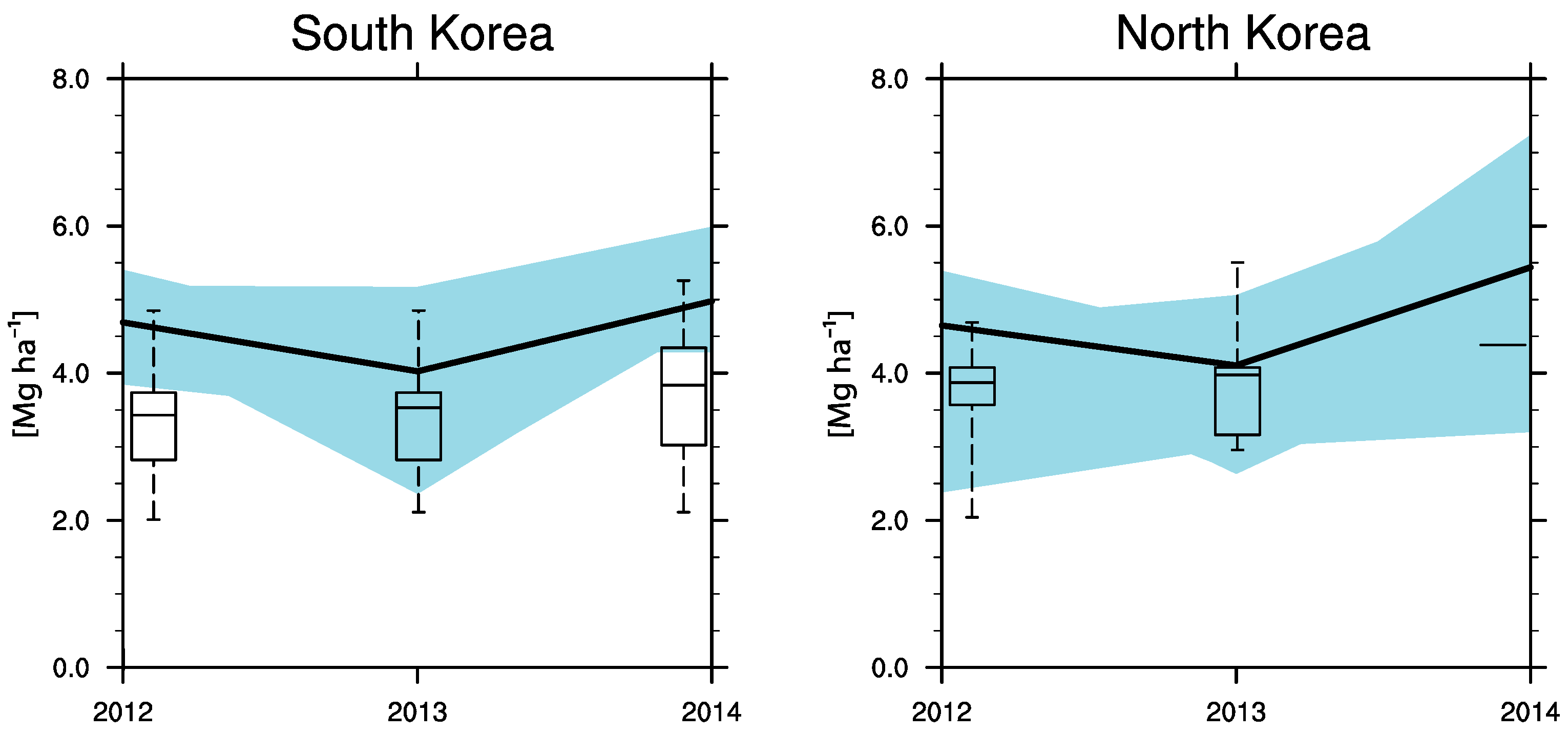

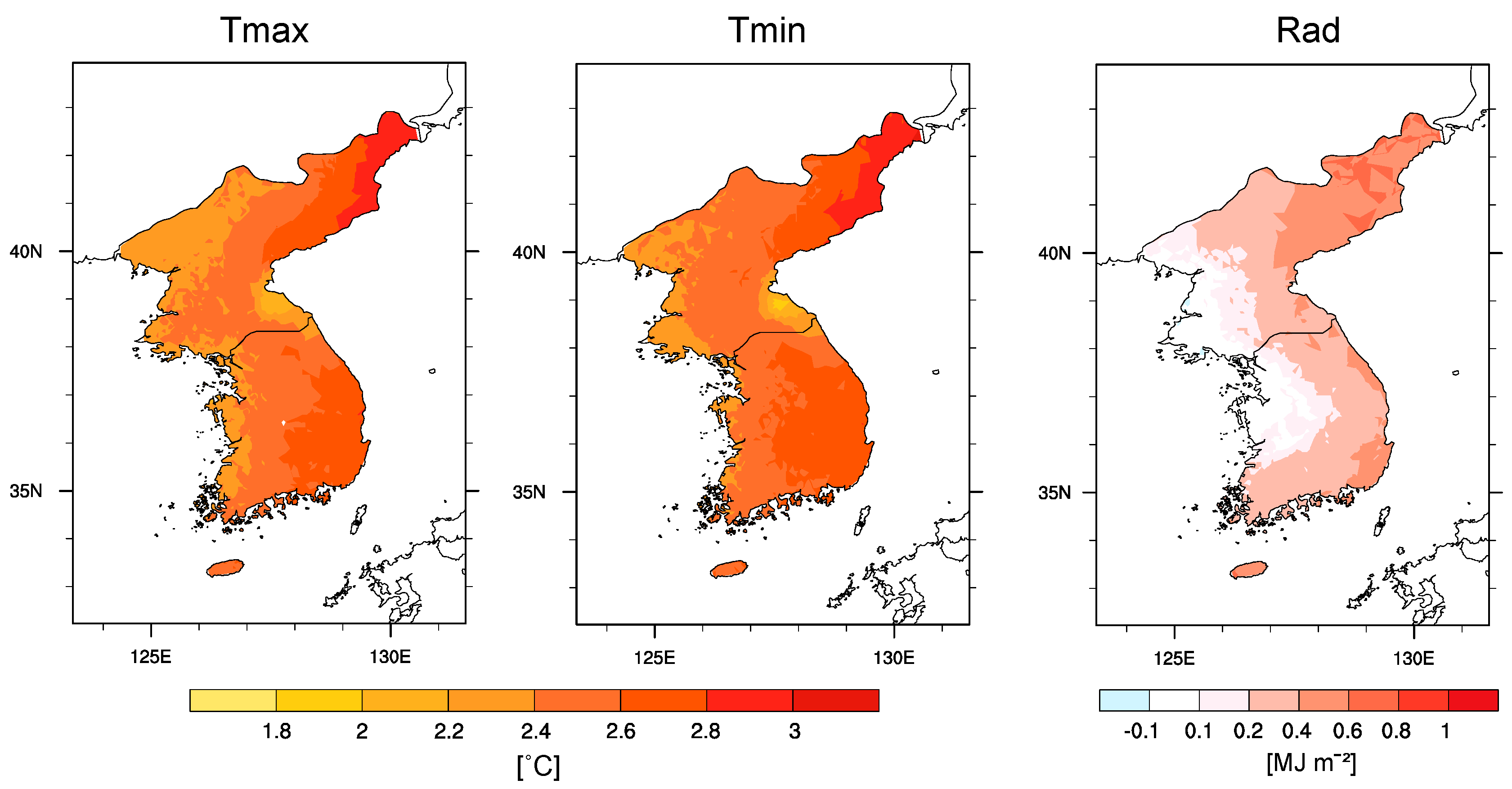
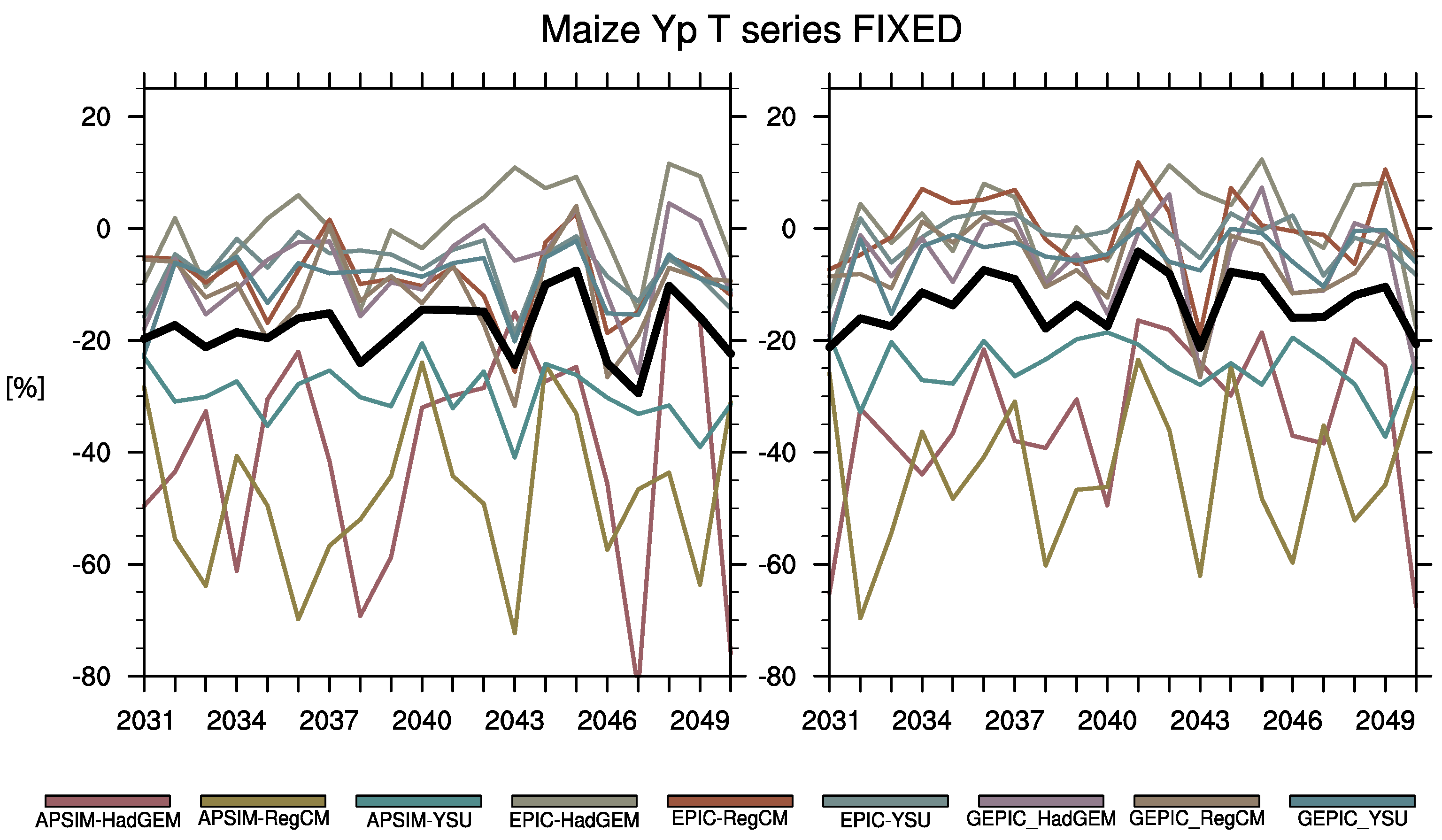


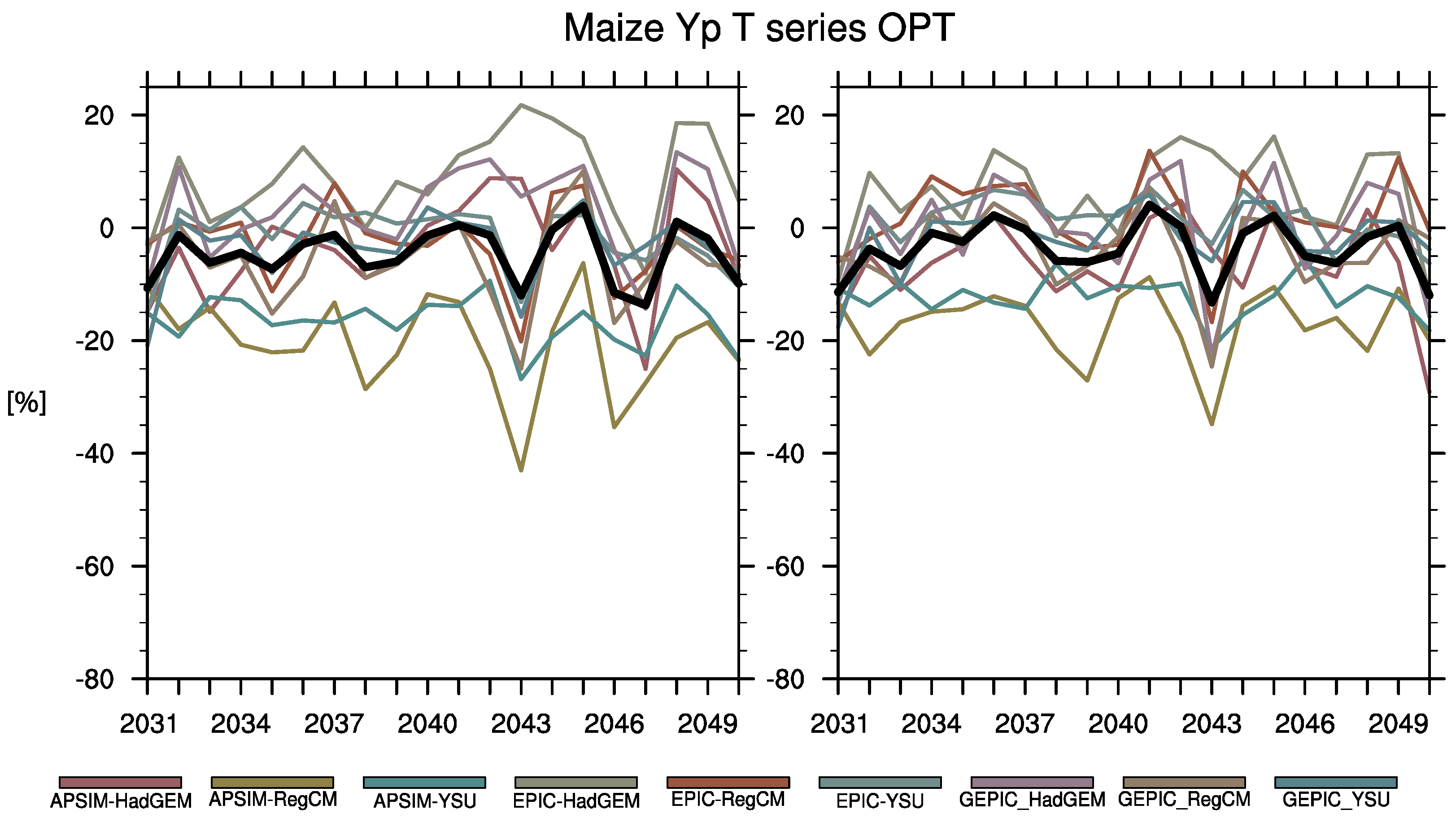

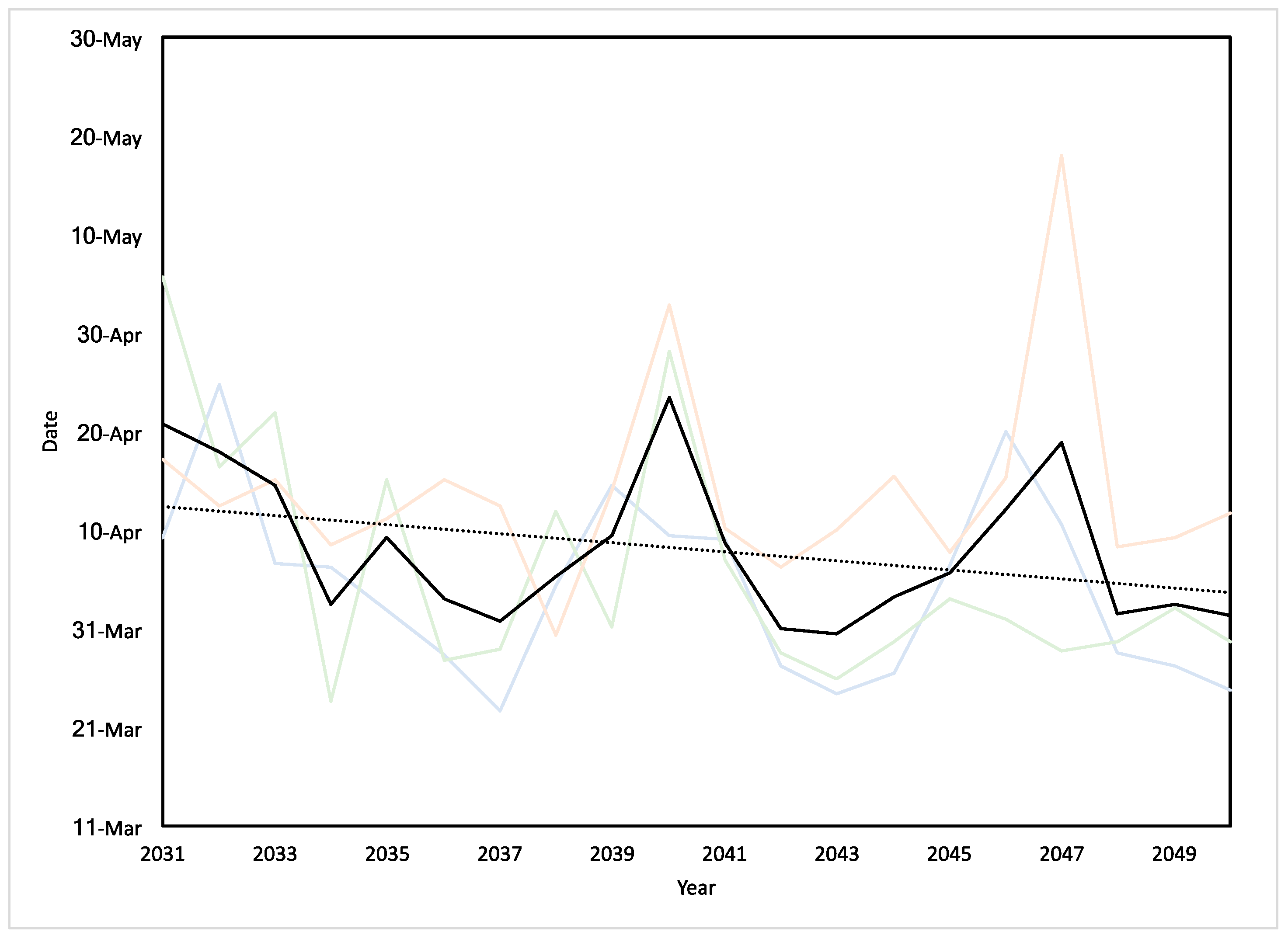
| Model | Institute | Description |
|---|---|---|
| HadGEM3-RA | National Institute of Meteorological Research (NIMR), South Korea | HadGEM3-RA is based on the global atmospheric Hadley Center Global Environmental Model version 3 (HadGEM3) of the Met Office Hadley Centre (MOHC) [16]. |
| RegCM4 | Kongju National University, South Korea | The Regional Climate Model version 4 (RegCM4), developed by the International Centre for Theoretical Physics (ICTP) with some noteworthy improvements, such as the coupling of a sophisticated land surface model, community land model 3 [17]. |
| YSU-RSM | Yonsei University, South Korea | Regional Spectral Model (RSM), which is also known as Regional Model Program (RMP) of the Global/Regional Integrated Model System (GRIMs) [18]. The dynamic frame of RMP is rooted in the National Center for Environmental Prediction (NCEP) RSM and most of physical parameterizations are newly developed and adapted to the RMP. |
| Model | Description | Daily Climate Input Data |
|---|---|---|
| ApsimRegions | Extended the point-specific Agricultural Production Systems sIMulator (APSIM) crop model to regional spatial scales (http://www.apsimregions.org) | Maximum Temperature, |
| Maximum Temperature, | ||
| Radiation, Precipitation | ||
| EPIC | Environmental Policy Integrated Climate (EPIC, v. 0810) | Maximum Temperature, |
| Maximum Temperature, | ||
| Radiation, Precipitation | ||
| GEPIC | GIS-based Environmental Policy Integrated Climate (EPIC) model v. 0509. The EPIC model us integrated with a GIS by a loose coupling approach | Maximum Temperature, |
| Maximum Temperature, | ||
| Radiation, Precipitation |
© 2017 by the authors. Licensee MDPI, Basel, Switzerland. This article is an open access article distributed under the terms and conditions of the Creative Commons Attribution (CC BY) license (http://creativecommons.org/licenses/by/4.0/).
Share and Cite
Kafatos, M.C.; Kim, S.H.; Lim, C.-H.; Kim, J.; Lee, W.-K. Responses of Agroecosystems to Climate Change: Specifics of Resilience in the Mid-Latitude Region. Sustainability 2017, 9, 1361. https://doi.org/10.3390/su9081361
Kafatos MC, Kim SH, Lim C-H, Kim J, Lee W-K. Responses of Agroecosystems to Climate Change: Specifics of Resilience in the Mid-Latitude Region. Sustainability. 2017; 9(8):1361. https://doi.org/10.3390/su9081361
Chicago/Turabian StyleKafatos, Menas C., Seung Hee Kim, Chul-Hee Lim, Jinwon Kim, and Woo-Kyun Lee. 2017. "Responses of Agroecosystems to Climate Change: Specifics of Resilience in the Mid-Latitude Region" Sustainability 9, no. 8: 1361. https://doi.org/10.3390/su9081361






